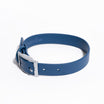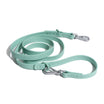Each flick, tilt, and twitch of your furry friend's ears paints a picture. You see, dogs' ear positions mean a lot more than most of us think. These movements are part of a rich, built-in language our canine companions have been speaking forever.
Dogs don't hide their feelings. In fact, their bodies are always saying something. We just have to tune in.
Why Your Dog's Ear Position Matters

Ear position shows your dog's feelings in the moment. When their ears move, they reflect emotions, from calm and focus to tension and fear. Paired with other body language signals, like tail position and eye shape, those ear movements help you understand what's going on inside your pup's head.
Dogs communicate with people and other animals using nonverbal cues. And their ears are one of the first things to change during a mood shift. Learning what those changing positions mean helps you respond the right way.
Upright Ears Facing Forward – Alert or Curious
Ears standing tall and facing forward are clear signs of focus and alertness. Your dog may be locked in on something, such as a sound, a movement, or another animal. Some breeds like German Shepherds, Huskies, and Belgian Malinois naturally have pointed ears, so this position looks more pronounced on them.
Also, watch your dog's body language for a stiff tail, a closed mouth, and wide-open eyes. This combination often means your pup is curiously gathering information and getting ready to respond.
Ears Slightly Tilted Back – Friendly or Submissive

It often means your dog is feeling friendly and welcoming when they pull their ears back just a little. This is common during gentle play or when greeting someone they know. You might also see soft eyes, a lowered tail, and an open mouth in a relaxed position.
This ear position can also show mild submission. If the rest of the body stays loose and the tail wags low, your pup feels safe and social.
Pinned-Back Ears – Nervous, Submissive, or Scared

Ears pinned flat against the head are a clear signal that your pup feels nervous, scared, or unsure. This position shows up fast whenever a dog feels overwhelmed or uneasy in new situations. Here's what you need to know:
-
When To Look for Other Stress Signals. Watch for signs like wide-open eyes, a tucked tail, and an overall tense posture. These clues help confirm if your dog is upset.
-
How to Comfort a Nervous Dog. Keep things quiet. Give your pet space, and don't force interaction. For extra support, Holistapet's CBD Calming Treats may help with anxious behaviors during stressful moments. Using broad-spectrum CBD (no THC), your pooch can chill out without feeling out of it.
One Ear Up, One Ear Down – Confused or Listening Closely

This uneven ear setup usually means your pup is trying to figure something out. It's a common look when dogs hear a sound they don't fully understand or when they're deciding how to respond. You might also see a tilted head, a still posture, and focused eyes. This one is a thinking pose. Your pet's brain is working, and their ears are showing it.
When It's Just a Habit vs. A Mood Indicator
For some dogs, a tilted ear or lopsided look might just be their default setting, not a sign of confusion or any other emotion. This is especially true in breeds with soft cartilage or mixed ear types.
To know the difference, watch for changes. If your pet usually keeps one ear flopped but suddenly perks both up, that shift means something. Context matters.
Flattened Ears – Fearful or Defensive

Flattened ears pressed tight against the head often mean your dog feels scared or threatened. This is a defensive posture, especially when paired with a generally stiff posture, a low tail, and wide eyes. If your pup freezes, growls, and tries to back away, take that as a warning. Give them space and stay cool to avoid adding more tension.
What To Do When Your Dog Shows Fear
Start by creating space and lowering stimulation that can make things worse, such as loud noises, quick movements, and unfamiliar faces. Keep your voice soft and avoid direct eye contact if your dog seems overwhelmed. Let them come to you when ready. And when they do, offer a safe spot, like their bed or crate, where they feel secure.
For extra support, HolistaPet's calming CBD products for dogs can help ease anxious behaviors during tough moments. Choose from our CBD chews, treats, oils, and capsules—all natural, vet-approved, and third-party lab tested for your peace of mind.
Droopy or Relaxed Ears – Calm and Content

This relaxed ear position often shows up when your dog is relaxing and enjoying quiet time. It's a sign of comfort, not boredom. Look for loose body posture, a soft gaze, and a slightly open mouth. The tail may wag gently or stay still. In this state, your furry friend feels safe and content with their surroundings.
Breed-Specific Ear Positions: What's Normal?
Each dog's ear shape sets the baseline for how their ears move. For example, a Basset Hound's long, floppy ears won't behave like the stiff ears of a German Shepherd. Compare any changes in ear position to your pet's usual look, not to a different breed's behavior. What's "alert" for one may be "relaxed" for another.
Natural Erect Ears vs. Floppy Ears
Dogs with erect ears, like Huskies and German Shepherds, show ear movement clearly. Every tilt, perk, and shift signals a reaction. Their ears act like radar, always adjusting based on what they see and hear.
Floppy-eared breeds, like Basset Hounds and Beagles, rely more on body posture and facial expression. Since their ears don't move much, you'll need to watch the rest of their body for emotional cues.
Breed Traits That Affect Ear Expression
Cartilage strength, ear size, and head shape influence how dogs use their ears. Breeds with thicker ear bases or heavy ear flaps may not show quick movements. Their ears shift subtly, so it takes extra attention to spot changes.
Some canines also have ear positions that shift over time, like during puppy growth or after physical activity. It's important to get familiar with your dog's normal range of ear motion. Once you know what's typical, it's easier to notice when something's not quite right.
When Ear Position Signals a Health Concern
A sudden change in ear position can point to a problem. If one ear droops when it's usually upright, or if your dog keeps shaking their head, there might be something wrong. Pay attention if they avoid touch near the ears or show redness on the outer ear. Here are other reminders:
-
Ear Infections, Mites, or Injuries. Look for swelling, foul odor, and constant scratching. These signs often show up before other symptoms and may affect your dog's ear position.
-
When To Visit Your Vet. If your pet's discomfort lasts more than a day or gets worse, it's time to call the vet. Early care helps prevent serious issues.
Other Body Language To Watch With Ear Movement
Your dog's ears give you only one part of their message. The rest of their body fills in the details. Watch your dog's body language in different settings. Their ears might perk up, but the meaning depends on their posture, eye shape, and tail position. Read the full picture to get the clearest view of what your dog is trying to say.
Tail Position, Posture, and Eye Contact
A raised tail, stiff posture, and direct eye contact often signal alertness and tension. Combine those with upright ears, and your pup is fully focused on something, maybe even feeling protective.
A low tail, loose posture, and soft eyes usually point to a relaxed dog. If the ears drop, too, your pet is likely in a chill state. On the other hand, wide eyes and stiff movement paired with pinned ears can mean discomfort.
Tips for Reading Your Dog's Ear Signals Accurately

Learning to read ear movement takes practice. Start by watching your pup during quiet moments, playtime, and new experiences. Their patterns will teach you more than a chart ever could.
-
Learn Your Dog's "Baseline" Expression. Some dogs hold their ears higher or lower by default. Get to know what "neutral ears" look like for your pup, so you can spot even small changes.
-
Don't Rely on Ears Alone—Use the Full Body Language Clues. Ears are just one signal. Always check their posture, tail movement, and facial tension to understand the full message.
FAQ – People Also Ask About Dog Ear Position Meaning
Understanding what your dog's ear positions mean gets easier when you know what's typical for them and what's not. These next few sections clear up what those movements really mean and how dog owners like you can respond with confidence.
Do dog ear positions change with age or training?
Yes, ear positions can shift with age, especially in puppies. As cartilage firms up, ears might perk, flop, or settle into a new shape. This change is normal and depends on the dog's breed and genetics.
Training can also influence ear movement. A dog learning new commands and social skills may show more focused ear positions during training sessions. With time, their body language becomes easier to read. Keep watching for subtle changes as your pooch grows and gains experience.
Can cropped ears affect a dog's ability to communicate?
Yes, cropped ears can limit how clearly a dog expresses emotion. Natural ear positions help signal mood shifts. Removing part of the ear changes how those signals appear to both people and other dogs. Pups with cropped ears may still communicate well using their posture, eyes, and tail, but some social cues do get lost. This can lead to misunderstandings during interactions, especially with other canines.
How do I know if my dog's ears show pain or discomfort?
Watch for sudden changes in position, like a normally perky ear going limp or tilting oddly. Head shaking, pawing at the ear, and avoiding touch near the head are also common signs. These shifts often come with redness, swelling, and a strange smell around the outer ear. When in doubt, check with your veterinarian to rule out injury, infection, and mites.
Final Thoughts – Listening to What Your Dog's Ears Are Saying
Your dog's ears speak volumes. Every shift, flick, and tilt offers a clue about how they feel. Learning to read those signs helps you build better communication and trust with your furry friend.
If your pup struggles with loud noises, new places, and daily stressors, HolistaPet's calming collection offers gentle support and can help relax those ears. Pay attention to the little signals, and those ear movements will start making a whole lot more sense.
Click here to continue with more dog care knowledge!







![Probiotics For Dogs [Soft Chews] - HolistaPet](http://www.holistapet.com/cdn/shop/files/Probiotic-Infographic-1_472d7a29-e30c-435a-9638-1365d8c3a9f9.jpg?v=1725384841&width=104)
















 Broad Spectrum CBD Oil for Dogs - Fast Acting
Broad Spectrum CBD Oil for Dogs - Fast Acting
 Chicken Flavored CBD Oil For Dogs - Easy Dose
Chicken Flavored CBD Oil For Dogs - Easy Dose
 Salmon Flavored CBD Oil For Dogs - Highly Rated
Salmon Flavored CBD Oil For Dogs - Highly Rated
 CBD Dog Treats for Anxiety - Loved by Thousands
CBD Dog Treats for Anxiety - Loved by Thousands





Leave a comment
All comments are moderated before being published.
This site is protected by hCaptcha and the hCaptcha Privacy Policy and Terms of Service apply.